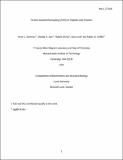| dc.contributor.author | Linse, Sara | |
| dc.contributor.author | Donovan, Kevin J | |
| dc.contributor.author | Jain, Sheetal Kumar | |
| dc.contributor.author | Griffin, Robert Guy | |
| dc.date.accessioned | 2018-11-05T17:09:17Z | |
| dc.date.available | 2018-11-05T17:09:17Z | |
| dc.date.issued | 2017-12 | |
| dc.date.submitted | 2017-09 | |
| dc.identifier.issn | 1520-6106 | |
| dc.identifier.issn | 1520-5207 | |
| dc.identifier.uri | http://hdl.handle.net/1721.1/118881 | |
| dc.description.abstract | Proton-assisted recoupling (PAR) is examined by exploring optimal experimental conditions and magnetization transfer rates in a variety of biologically relevant nuclear spin-systems, including simple amino acids, model peptides, and two proteins–nanocrystalline protein G (GB1), and importantly amyloid beta 1–42 (M₀Aβ₁₋₄₂) fibrils. A selective PAR protocol, SUBPAR (setting up better proton assisted recoupling), is described to observe magnetization transfer in one-dimensional spectra, which minimizes experiment time (in comparison to two-dimensional experiments) and thereby enables an efficient assessment of optimal PAR conditions for a desired magnetization transfer. In the case of the peptide spin systems, experimental and simulated PAR data sets are compared on a semiquantitative level, thereby elucidating the interactions influencing PAR magnetization transfer and their manifestations in different spin transfer networks. Using the optimum Rabi frequencies determined by SUBPAR, PAR magnetization transfer trajectories (or buildup curves) were recorded and compared to simulated results for short peptides. PAR buildup curves were also recorded for M₀Aβ₁₋₄₂ and examined conjointly with a recent structural model. The majority of salient cross-peak intensities observed in the M₀Aβ₁₋₄₂ PAR spectra are well-modeled with a simple biexponential equation, although the fitting parameters do not show any strong correlation to internuclear distances. Nevertheless, these parameters provide a wealth of invaluable semiquantitative structural constraints for the M₀Aβ₁₋₄₂. The results presented here offer a complete protocol for recording PAR ¹³C–¹³C correlation spectra with high-efficiency and using the resulting information in protein structural studies. | en_US |
| dc.description.sponsorship | National Institutes of Health (U.S.) (Grant EB-001960) | en_US |
| dc.description.sponsorship | National Institutes of Health (U.S.) (Grant AG-058504) | en_US |
| dc.description.sponsorship | National Institutes of Health (U.S.) (Grant EB-002026) | en_US |
| dc.language.iso | en_US | |
| dc.publisher | American Chemical Society (ACS) | en_US |
| dc.relation.isversionof | http://dx.doi.org/10.1021/acs.jpcb.7b08934 | en_US |
| dc.rights | Article is made available in accordance with the publisher's policy and may be subject to US copyright law. Please refer to the publisher's site for terms of use. | en_US |
| dc.source | Prof. Griffin via Erja Kajosalo | en_US |
| dc.title | Proton-Assisted Recoupling (PAR) in Peptides and Proteins | en_US |
| dc.type | Article | en_US |
| dc.identifier.citation | Donovan, Kevin J. et al. “Proton-Assisted Recoupling (PAR) in Peptides and Proteins.” The Journal of Physical Chemistry B 121, 48 (November 2017): 10804–10817 © 2017 American Chemical Society | en_US |
| dc.contributor.department | Massachusetts Institute of Technology. Department of Chemistry | en_US |
| dc.contributor.department | Francis Bitter Magnet Laboratory (Massachusetts Institute of Technology) | en_US |
| dc.contributor.approver | Griffin, Robert G. | en_US |
| dc.contributor.mitauthor | Donovan, Kevin J | |
| dc.contributor.mitauthor | Jain, Sheetal Kumar | |
| dc.contributor.mitauthor | Griffin, Robert Guy | |
| dc.relation.journal | Journal of Physical Chemistry B | en_US |
| dc.eprint.version | Author's final manuscript | en_US |
| dc.type.uri | http://purl.org/eprint/type/JournalArticle | en_US |
| eprint.status | http://purl.org/eprint/status/PeerReviewed | en_US |
| dspace.orderedauthors | Donovan, Kevin J.; Jain, Sheetal K.; Silvers, Robert; Linse, Sara; Griffin, Robert G. | en_US |
| dspace.embargo.terms | N | en_US |
| dc.identifier.orcid | https://orcid.org/0000-0001-5830-6748 | |
| dc.identifier.orcid | https://orcid.org/0000-0002-2966-9993 | |
| dc.identifier.orcid | https://orcid.org/0000-0003-1589-832X | |
| mit.license | PUBLISHER_POLICY | en_US |
